Radeon X1650/X1690 Roundup
|
TABLE OF CONTENTS
- Introduction
- Video cards' features
- Testbed configurations, benchmarks
- Test results
- Conclusions
If you've been consistently reading our materials of late, you might be wondering why we write much about NVIDIA products and publish nothing about AMD. Of course we do. We just devoted the entire November to new products from the Californian company, so much attention was paid to the GeForce 8800 series. But workaday routine started, the life returns to a rut: some products from AMD/ATI, some from NVIDIA. New Middle-End products from AMD/ATI have been launched recently, namely RADEON X1650 XT, X1950 PRO. Besides, old X1600 XT and X1600 PRO cards were renamed to X1650 PRO and X1300 XT correspondingly. Today we are going to examine some representatives of these families. Almost all of them are very interesting cards.
Video Cards
| Gigabyte RADEON X1650 PRO (GV-RX165P256D-RH) 256MB
PCI-E |
| GPU: RADEON X1650 PRO (ex.X1600 XT) (RV530) Interface: PCI-Express x16 GPU frequencies (ROPs/Shaders): 590/590 MHz (nominal — 590 (590) MHz) Memory frequencies (physical (effective)): 690 (1380) MHz (nominal — 690 (1380) MHz) Memory bus width: 128bit Vertex processors: 5 Pixel processors: 12 Unified processors: - Texture Processors: 4 ROPs: 4 Dimensions: 170x100x35 mm (the last figure is the maximum thickness of a video card). PCB color: blue. RAMDACs/TDMS: integrated into GPU. Output connectors: 2xDVI (Dual-Link), TV-Out. VIVO: not available TV-out: integrated into GPU. Multi-GPU operation: CrossFire (Software). |
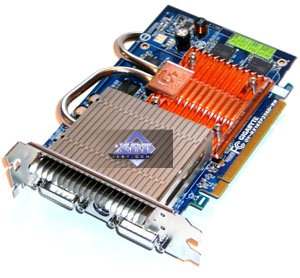
|
| GeCube RADEON X1950 PRO FZ Cool Fan 512MB PCI-E |
| GPU: RADEON X1950 PRO (RV570) Interface: PCI-Express x16 GPU frequencies (ROPs/Shaders): 575/575 MHz (nominal — 580 (580) MHz) Memory frequencies (physical (effective)): 680 (1360) MHz (nominal — 700 (1400) MHz) Memory bus width: 256bit Vertex processors: 8 Pixel processors: 36 Unified processors: - Texture Processors: 12 ROPs: 12 Dimensions: 220x100x37 mm (the last figure is the maximum thickness of a video card). PCB color: red. RAMDACs/TDMS: integrated into GPU. Output connectors: 2xDVI (Dual-Link), TV-Out. VIVO: not available TV-out: integrated into GPU. Multi-GPU operation: CrossFire (Hardware). |
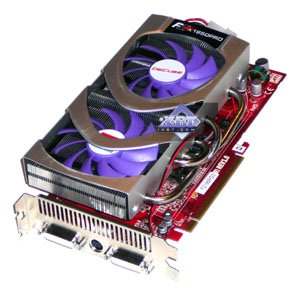
|
| HIS IceQ III RADEON X1650 XT Turbo 256MB PCI-E |
| GPU: RADEON X1650 XT (RV560) Interface: PCI-Express x16 GPU frequencies (ROPs/Shaders): 630/630 MHz (nominal — 600 (600) MHz) Memory frequencies (physical (effective)): 760 (1520) MHz (nominal — 700 (1400) MHz) Memory bus width: 128bit Vertex processors: 6 Pixel processors: 24 Unified processors: - Texture Processors: 8 ROPs: 8 Dimensions: 160x100x32 mm (the last figure is the maximum thickness of a video card). PCB color: red. RAMDACs/TDMS: integrated into GPU. Output connectors: 2xDVI (Dual-Link), TV-Out. VIVO: not available TV-out: integrated into GPU. Multi-GPU operation: CrossFire (Hardware). |

|
| HIS IceQ III RADEON X1950 PRO Turbo 256MB PCI-E |
| GPU: RADEON X1950 PRO (RV570) Interface: PCI-Express x16 GPU frequencies (ROPs/Shaders): 650/650 MHz (nominal — 580 (580) MHz) Memory frequencies (physical (effective)): 740 (1480) MHz (nominal — 700 (1400) MHz) Memory bus width: 256bit Vertex processors: 8 Pixel processors: 36 Unified processors: - Texture processors: 12 ROPs: 12 Dimensions: 220x100x37 mm (the last figure is the maximum thickness of a video card). PCB color: red. RAMDACs/TDMS: integrated into GPU. Output connectors: 2xDVI (Dual-Link), TV-Out. VIVO: not available TV-out: integrated into GPU. Multi-GPU operation: CrossFire (Hardware). |
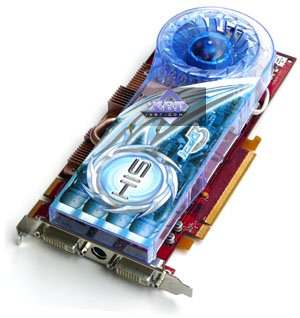
|
| Sapphire RADEON X1650 XT 256MB PCI-E |
| GPU: RADEON X1650 XT (RV560) Interface: PCI-Express x16 GPU frequencies (ROPs/Shaders): 600/600 MHz (nominal — 600 (600) MHz) Memory frequencies (physical (effective)): 700 (1400) MHz (nominal — 700 (1400) MHz) Memory bus width: 128bit Vertex processors: 6 Pixel processors: 24 Unified processors: - Texture processors: 8 ROPs: 8 Dimensions: 160x100x15mm (the last figure is the maximum thickness of a video card). PCB color: blue. RAMDACs/TDMS: integrated into GPU. Output connectors: 2xDVI (Dual-Link), TV-Out. VIVO: not available TV-out: integrated into GPU. Multi-GPU operation: CrossFire (Hardware). |

|
| Sapphire RADEON X1950 PRO 256MB PCI-E |
| GPU: RADEON X1950 PRO (RV570) Interface: PCI-Express x16 GPU frequencies (ROPs/Shaders): 580/580 MHz (nominal — 580 (580) MHz) Memory frequencies (physical (effective)): 700 (1400) MHz (nominal — 700 (1400) MHz) Memory bus width: 256bit Vertex processors: 8 Pixel processors: 36 Unified processors: - Texture processors: 12 ROPs: 12 Dimensions: 220x100x15mm (the last figure is the maximum thickness of a video card). PCB color: blue. RAMDACs/TDMS: integrated into GPU. Output connectors: 2xDVI (Dual-Link), TV-Out. VIVO: not available TV-out: integrated into GPU. Multi-GPU operation: CrossFire (Hardware). |

|
| Sapphire RADEON X1950 PRO Ultimate 256MB PCI-E |
| GPU: RADEON X1950 PRO (RV570) Interface: PCI-Express x16 GPU frequencies (ROPs/Shaders): 580/580 MHz (nominal — 580 (580) MHz) Memory frequencies (physical (effective)): 700 (1400) MHz (nominal — 700 (1400) MHz) Memory bus width: 256bit Vertex processors: 8 Pixel processors: 36 Unified processors: - Texture processors: 12 ROPs: 12 Dimensions: 220x100x40mm (the last figure is the maximum thickness of a video card). PCB color: blue. RAMDACs/TDMS: integrated into GPU. Output connectors: 2xDVI (Dual-Link), TV-Out. VIVO: not available TV-out: integrated into GPU. Multi-GPU operation: CrossFire (Hardware). |

|
| Gigabyte RADEON X1650 PRO (GV-RX165P256D-RH) 256MB
PCI-E; HIS IceQ III RADEON X1650 XT Turbo 256MB PCI-E; |
| The card has 256 MB GDDR3 SDRAM allocated in four chips on the front side of the PCB. Infineon memory chips (GDDR3). 1.4 ns memory access time, which corresponds to 700 (1400) MHz. |

|
| Sapphire RADEON X1950 PRO 256MB PCI-E; Sapphire RADEON X1950 PRO Ultimate 256MB PCI-E; HIS IceQ III RADEON X1950 PRO Turbo 256MB PCI-E |
| The video card has 256 MB of GDDR3 SDRAM allocated in eight chips on the front side of the PCB. Samsung (GDDR3) memory chips. 1.2 ns memory access time, which corresponds to 800 (1600) MHz. |

|
| GeCube RADEON X1950 PRO FZ Cool Fan 512MB PCI-E |
| The video card has 512 MB of GDDR3 SDRAM allocated in eight chips on the front side of the PCB. Samsung (GDDR3) memory chips. 1.2 ns memory access time, which corresponds to 800 (1600) MHz. |

|
| Sapphire RADEON X1650 XT 256MB PCI-E |
| The video card has 256 MB of GDDR3 SDRAM allocated in four chips on the front side of the PCB. Infineon memory chips (GDDR3). 1.3 ns memory access time, which corresponds to 750 (1500) MHz. |

|
| Comparison with the reference design,
front view |
|
Gigabyte RADEON X1650 PRO (GV-RX165P256D-RH)
256MB PCI-E
|
Reference card ATI RADEON X1600 XT
|
|
|
|
|
HIS IceQ III RADEON X1650 XT Turbo 256MB PCI-E
|
|
|
|
Sapphire RADEON X1650 XT 256MB PCI-E
|
|
|
|
|
|
Sapphire RADEON X1950 PRO 256MB PCI-E
|
Reference card ATI RADEON X1950 PRO
|
|
|
|
|
|
|
Sapphire RADEON X1950 PRO Ultimate 256MB PCI-E
|
|
|
|
HIS IceQ III RADEON X1950 PRO Turbo 256MB
PCI-E
|
|
|
|
GeCube RADEON X1950 PRO FZ Cool Fan 512MB
PCI-E
|
|
|
| Comparison with the reference design,
back view |
|
Gigabyte RADEON X1650 PRO (GV-RX165P256D-RH)
256MB PCI-E
|
Reference card ATI RADEON X1600 XT
|
|
|
|
|
HIS IceQ III RADEON X1650 XT Turbo 256MB PCI-E
|
|
|
|
Sapphire RADEON X1650 XT 256MB PCI-E
|
|
|
|
Sapphire RADEON X1950 PRO 256MB PCI-E
|
Reference card ATI RADEON X1950 PRO
|
|
|
|
|
Sapphire RADEON X1950 PRO Ultimate 256MB PCI-E
|
|
|
|
HIS IceQ III RADEON X1950 PRO Turbo 256MB
PCI-E
|
|
|
|
GeCube RADEON X1950 PRO FZ Cool Fan 512MB
PCI-E
|
|
|
While video cards based on 1950 PRO from HIS and Sapphire are just copies of the reference design, the product from Gecube is based on a unique PCB. You can see it right away - the external power connector is moved up, while the reference design has it in the center of a PCB, at the end of it, of course. But we don't know whether it was the reference design that was modified. That may be a copy of a new reference card. But the main attraction of this card is its cooler, we'll talk about it later. Frequencies of this card are reduced a little, but 512 MB of memory in large resolutions, where gameplay doesn't drop to minimum, still allowed to perform not only no worse, but sometimes even better than its 256 MB counterparts. Similar accelerators based on 1950 PRO from HIS/Sapphire differ from each other in PCB colors, cooling systems, and frequencies. It should be noted that HIS does not place its hopes only in iTurbo (this utility raises operating frequencies of video cards), when it adds the Turbo suffix to its cards. The company raises operating frequencies of these cards in BIOS. That's why X1950 PRO and X1650 XT operate at higher frequencies. The product from Gigabyte, based on old X1600 XT - now called X1650 PRO, is almost no different from the reference design. The spirit is in the cooler. The cards have TV-Out with a unique jack. You will need a special bundled adapter to output video to a TV-set via S-Video or RCA. You can read about the TV-Out in more detail here. Analog monitors with d-Sub (VGA) interface are connected with special DVI-to-d-Sub adapters. Maximum resolutions and frequencies:
- 240 Hz Max Refresh Rate
- 2048 x 1536 x 32bit x85Hz Max - analog interface
- 2560 x 1600 @ 60Hz Max - digital interface
What concerns MPEG2 playback features (DVD-Video), we analyzed this issue in 2002. Little has changed since that time. CPU load during video playback on all modern video cards does not exceed 25%. Now about the cooling systems. There is no point in examining the coolers from HIS cards, because they are the same devices from Arctic Cooling that we reviewed many times.
| Gigabyte RADEON X1650 PRO (GV-RX165P256D-RH) 256MB
PCI-E |
|
Passive cooling system, i.e. no fan. It consists of two heatsinks. One of them is on the front side of the card and borders with the card bracket. It contributes to channeling the heat out of a PC case due to air flows inside it. The second heatsink is on the back side. Both of them channel the heat away from the GPU via heat pipes with low-boiling liquid inside. The device is absolutely reliable. We had no problems with overheating, temperature was kept within admissible limits. Noiseless operation is guaranteed. It's a very good solution for such cards. It can be overclocked to 640/1500 MHz |
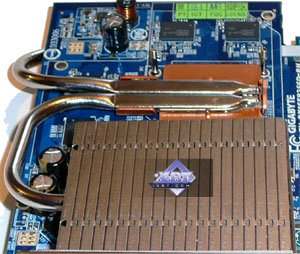
|
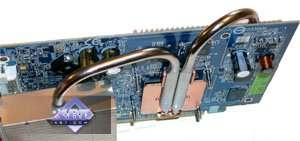
|

|

|
| Sapphire RADEON X1650 XT 256MB PCI-E |
|
A nice flat cooler with the standard mode of operation - its fan drives air along the heatsink. A plastic housing covers the heatsink fully, so there is practically no noise. Memory chips are also cooled by the same cooler, which may help overclock memory. Maximum frequencies for this sample are 640/1580 MHz |

|
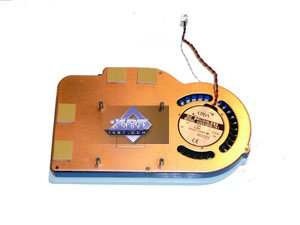
|
| Sapphire RADEON X1950 PRO 256MB PCI-E |
|
This device is similar to the previous one in its operation. Although it looks good, this long plastic housing and curved heatsink fins generate nasty noise. Sad, but true. The engineers tried to raise efficiency and sacrificed quiet operation. It's a wrong approach for these days. We managed to overclock the card to 630/1750 MHz. |
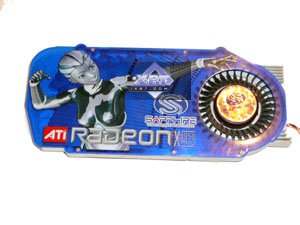
|

|
| Sapphire RADEON X1950 PRO Ultimate 256MB PCI-E |
|
In this case, a special cooler from Zalman is the key feature of this card that gives it the right for the Ultimate suffix. It's justified! Its GPU can be overclocked from 580 MHz to 690(!) MHz! Impressive. Besides, the cooler is guaranteed to remain quiet! The cooler itself is a round funnel made of copper plates, its edges are formed by copper heat pipes that channel the heat from the funnel base - the heatsink base. There is a low-speed fan in the center of the funnel, it rotates at 1500 rpm.
|

|

|
| GeCube RADEON X1950 PRO FZ Cool Fan 512MB PCI-E |
|
GeCube engineers decided to equip the card not only with more memory than in usual 1950 PRO cards, but also to install a monster of a cooler on the GPU - it takes up three slots instead of two. As we can see, it's a two-fan system with a huge heatsink. It uses heat pipes, of course. They are used everywhere now... A general drawback of this cooling system - memory chips are not cooled at all, but efficient heat dissipation from such a core as X1950 PRO does not require such a monster. It's not X1950 XTX. It can only please overclockers. By the way, the cooler plays its role - the core worked well at 695 MHz. |

|

|

|
We monitored the card from GeCube using famous RivaTuner (written by A. Nikolaychuk AKA Unwinder):
Bundle
| Gigabyte RADEON X1650 PRO (GV-RX165P256D-RH) 256MB
PCI-E |
| User manual, CD with drivers, Civilization 4, DVI-to-d-Sub and S-Video-to-RCA adapters, composite-out adapter. |

|
| GeCube RADEON X1950 PRO FZ Cool Fan 512MB PCI-E |
| User manual, CD with drivers, DVI-to-d-Sub and S-Video-to-RCA adapters, composite-out adapter, bracket grille, external power adapter. |

|
| HIS IceQ III RADEON X1650 XT Turbo 256MB PCI-E; HIS IceQ III RADEON X1950 PRO Turbo 256MB PCI-E |
| User manual, CD with drivers, CD with a game, DVI-to-d-Sub and S-Video-to-RCA adapters, composite-out adapter, bracket grille, external power adapter (1950 PRO only), CrossFire adapter.
|

|
| Sapphire RADEON X1650 XT 256MB PCI-E; Sapphire RADEON X1950 PRO 256MB PCI-E |
| The previous bundle is supplemented by TV-Out cables. The bundled game is replaced by "Da Vinci Code".
|

|
| Sapphire RADEON X1950 PRO Ultimate 256MB PCI-E |
| The same bundle, but it's got another game.
|

|
Packages
| Gigabyte RADEON X1650 PRO (GV-RX165P256D-RH) 256MB
PCI-E |
|
It's a large glossy package with a cardboard box inside. The card and all bundled components are secured inside, so they don't dangle. |
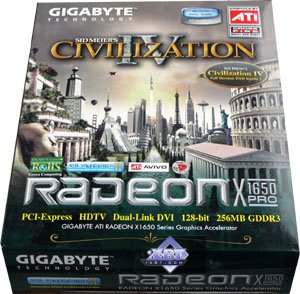
|
| GeCube RADEON X1950 PRO FZ Cool Fan 512MB PCI-E |
|
The same thing. It's a large and bright glossy box in the traditional GeCube style. But it has a window on the front side to show off the card. All bundled components are thoroughly arranged into sections. The video card is secured not to dangle inside. |
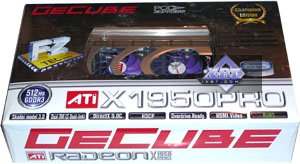
|
| HIS IceQ III RADEON X1650 XT Turbo 256MB PCI-E |
|
It's a traditional box we've seen many times: blue-white design, an oval window to show off the card, all components are arranged into plastic sections inside. It's an excellent box! |

|
| HIS IceQ III RADEON X1950 PRO Turbo 256MB PCI-E |
|
It's a new design from HIS. We have started seeing such boxes since X1900. I like it even better. Besides, it retains all advantages of the previous version - cards are secured well in plastic. |
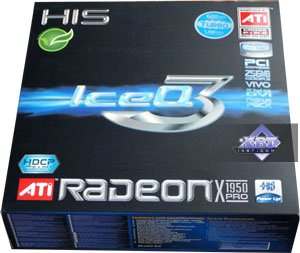
|
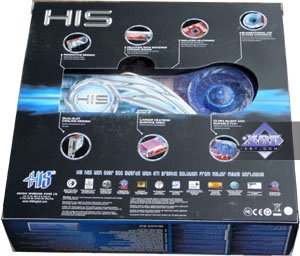
|
| Sapphire RADEON X1650 XT 256MB PCI-E |
|
After a couple of years of the updated box design (bright boxes with windows to show off cards, all bundled components are packed in plastic like in HIS boxes), Sapphire box designers fell into depression. They changed the design a little - white with black patterns. But the plastic inside disappeared, and all those cardboard partitions are not worth a brass farthing. |

|
| Sapphire RADEON X1950 PRO 256MB PCI-E |
|
That's why all cards, except thickest ones that are just pinched in a box, dangle inside. It's regress instead of progress. Alas. |
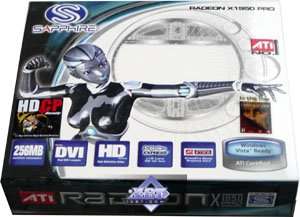
|
| Sapphire RADEON X1950 PRO Ultimate 256MB PCI-E |
|
In this case designers went to another extreme: how can you secure a card inside a huge box as if it's poised in the air? The answer is simple: Make a huge box of expensive plastic, put huge retention module inside and place the card in it. The result looks great, of course. But distributors wonder how much air they'll have to transport with these cards. |
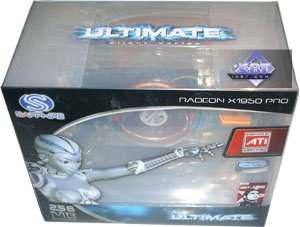
|
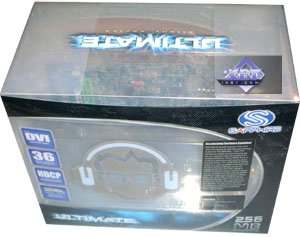
|
Installation and Drivers
Testbed configuration:
- Intel Core2 Duo (775 Socket) based computer
- CPU: Intel Core2 Duo Extreme X6800 (2930 MHz) (L2=4096K)
- Motherboard: EVGA nForce 680i SLI on NVIDIA nForce 680i
- RAM: 2 GB DDR2 SDRAM Corsair 1142MHz (CAS (tCL)=5; RAS to CAS delay (tRCD)=5; Row Precharge (tRP)=5; tRAS=15)
- HDD: WD Caviar SE WD1600JD 160GB SATA
- Operating system: Windows XP SP2 DirectX 9.0c
- Monitor: Dell 3007WFP (30") (and Mitsubishi Diamond Pro 2070sb (21")).
- ATI CATALYST 6.11; NVIDIA Drivers 96.94.
VSync is disabled.
Test results: performance comparison
We used the following test applications:
Video cards' performance
You may download the results in Excel format (Office 2003) archived in RAR 3.0 or ZIP.
- 1. Far Cry, Research (No HDR)
- 2. Far Cry, Research (HDR)
- 3. Splinter Cell Chaos Theory (No HDR)
- 4. Splinter Cell Chaos Theory (HDR)
- 5. Half Life2, ixbt01
- 6. DOOM III
- 7. 3DMark05 MARKS
- 8. Chronicles of Riddick, demo 44
- 9. F.E.A.R.
- 10. Call Of Duty 2 DEMO
- 11. 3DMark 06, Shader Model 2.0 MARKS
- 12. 3DMark 06, Shader Model 3.0 MARKS
Conclusions
Gigabyte RADEON X1650 PRO (GV-RX165P256D-RH) 256MB PCI-E is a very good product for its price. Its performance is similar to that of the X1600 XT, so it can easily compete with the 7600GS. Its noiseless cooling system makes the card even more attractive. Our sample worked great, we had no gripes with it. GeCube RADEON X1950 PRO FZ Cool Fan 512MB PCI-E is an interesting product. We've been thinking much, evaluating all pros and cons of this cooler. We decided that it has more advantages than disadvantages, despite its dimensions. This cooling system is almost quiet, and users have been trying to keep the first slots after a video card empty for a long time already. We also had no gripes with our sample. We should also mention a nice-looking overclocking utility, as this product is designed for overclockers. Unfortunately, memory chips are not equipped with heatsinks. HIS IceQ III RADEON X1650 XT Turbo 256MB PCI-E is very good competitor to GeForce 7600 GT. But it enjoys such advantages as HDR+AA, higher-quality anisotropy. In case of the product from HIS, we can add an excellent cooling system, very efficient and noiseless. Add increased frequencies and... Alas, there will be no fanfares. It's almost impossible to get such cards in Russia. They are not shipped to our country. :-( HIS IceQ III RADEON X1950 PRO Turbo 256MB PCI-E is also an excellent product in every respect! It's got increased frequencies, an excellent cooler, and a good bundle. As you can see on the diagrams, this card outperforms all its competitors. But HIS products are hard to get, to say nothing about new IceQ products. Sapphire RADEON X1650 XT 256MB PCI-E is a good competitor to the 7600GT. It has a good bundle and a practically noiseless cooler. If the prices are adequate, you should keep in mind better anisotropy and HDR+AA when you make your choice. The quality of these cards is very high. Sapphire RADEON X1950 PRO 256MB PCI-E is also a good competitor to GeForce 7900 GS. But its noisy cooling system spoils the impression. Engineers did not take into account the noise generated by large plastic caps of such heatsinks that happens in many models. Sapphire RADEON X1950 PRO Ultimate 256MB PCI-E is a very good card, it lacks the drawback of the previous product and offers excellent overclocking capacities. The only question is how soon these cards will appear in stores, if they will. And at what price.
You can find more detailed comparisons of various video cards in our 3Digest.
Our Original Design award
is given to...
- HIS IceQ III RADEON X1650 XT Turbo 256MB PCI-E;
- HIS IceQ III RADEON X1950 PRO Turbo 256MB PCI-E;
- Sapphire RADEON X1950 PRO Ultimate 256MB PCI-E;
- GeCube RADEON X1950 PRO FZ Cool Fan 512MB PCI-E
- Gigabyte RADEON X1650 PRO (GV-RX165P256D-RH) 256MB PCI-E
PSU for the testbed was kindly provided by TAGAN

|
|
The Dell 3007WFP monitor for the testbeds was kindly provided by NVIDIA

|
Write a comment below. No registration needed!
|
|
 |
|
|
|


